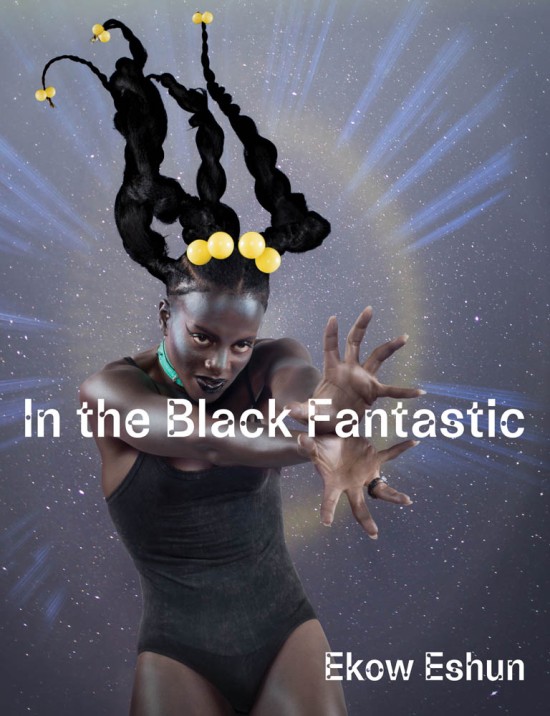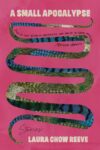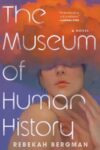
[MIT Press; 2022]
Tracy K. Smith’s poem “Sci Fi,” included in her Pulitzer-winning Life on Mars (2012), portends a future. The first of the ten couplets declares: “There will be no edges but curves. / Clean lines pointing only forward.” At warp speed, the Starship Enterprise jumps to mind. For Smith, this aesthetic of smoothness reshapes even epistemology, rounding away the known and knowable:
History, with its hard spine & dog-eared
Corners, will be replaced with nuance,
Just like the dinosaurs gave way
To mounds and mounds of ice.
Smith next lists other trivialities that—like history, corners, and dinosaurs— will go extinct. Gender. Sex. The sun. Even aging, according to what the poem cites as the “popular consensus” of futurological clichés, will dwindle. Science fiction promises this ambivalent horizon of human longevity that is likened to the inhospitable barrens of “mounds of mounds of ice.” Space is cold, after all, and it is this freezing void that waits at the end of the poem:
Eons from even our own moon, we’ll drift
In the haze of space, which will be, once,
And for all, scrutable and safe
With this final floating line, set adrift like the “we” of the poem, Smith suggests that utopia is coincident with oblivion. The time and place of universal flourishing—a world made “scrutable and safe,” with liberty and justice “for all”—is far-flung infinitude, a “haze of space” that is no place fit for life. Who could survive such an advent of equality? According to the Marxist theorist Fredric Jameson, “someone once said that it is easier to imagine the end of the world than to imagine the end of capitalism.” For Smith, it is only by imagining the end of existence that we can imagine the end of inequity.
Smith’s mordant reflection on the pleasures and perils of projecting smoother times to come finds compelling company with In the Black Fantastic, the companion book for an art exhibition of the same name staged at London’s Hayward Gallery in the summer of 2022. Curated by the British writer, journalist, and broadcaster Ekow Eshun, the exhibition focused on the work of eleven contemporary visual artists who identify with the Black diaspora, each of whom incorporates fantastical speculative elements to explore issues of race, memory, myth, history, and possibility. Space travel, time travel, surrealism, ornate ceremony, and bodily transmogrification featured centrally. Rather than ignoring reality, fantasy here functioned as what the show’s website calls “a zone of creative and cultural liberation and a means of addressing racism and social injustice by conjuring new ways of being in the world.” Or, as Eshun explains in an interview with BFI’s Chrystel Oloukoï, “the fantastic is not a territory of escape. It’s a way of riposte and a method of reply to a racialised everyday, but it’s also an assertion of freedom.” Like Smith’s closing image of endlessly drifting impartiality, this asserted freedom is never naïvely triumphant. Even surging past the final frontier, the Black fantastic remains aware of the constraints it aims to explode.
The art displayed at the Hayward ranged across material, media, style, and tone, and the gathered artists from around the world and from divergent career stages. Kara Walker and Nick Cave, both based in the United States, were the famous headliners of the bunch. Others, such as Chris Ofili, Ellen Gallagher, Hew Locke, Wangechi Mutu, and Cauleen Smith are well-established in that chimera we might call “the international art community.” The final four, Sedrick Chisom, Rashaad Newsome, Tabita Rezaire, and Lina Iris Viktor, are newer to the global scene, relatively younger and less widely known—or at least, they were less known before this show’s smash success catapulted their work to newfound prominence. Indeed, “In the Black Fantastic” was hailed as a landmark achievement, praised for its originality, force, and focus by the likes of The Guardian, New York Times, and Vogue, and “recommended” by a slightly more persnickety review in Time Out. Fortunately, for anyone who missed the show, this new book, edited by curator Eshun, provides not only a stunning approximation of the original spectacle but adds layers of historical context and conceptual insight.
The bulk of In the Black Fantastic‘s three hundred pages is given over to a deluge of gloriously full color image plates. As a column in the volume’s front matter explains—or perhaps warns—the images are “sequenced outside of the normal conventions of chronology, media or genre;” this is done to “show the connections that can be made across art forms” in the “freeform spirit” of the Black fantastic. Still, some crucial order does obtain. Importantly, sample works from the eleven focus artists are provided early in the form of black-backgrounded recto-verso spreads. Meant to reproduce on the page the areas of the original exhibition apportioned for the respective artists, this stark visual series is set apart from the frenetic blend of the rest of the book, and it follows Eshun’s introduction essay, “The Art of the Black Fantastic,” which weaves text around smaller reproductions of works by the main players and by a panoply of claimed predecessors. This opening overview is a provocative account of the Black fantastic construed as “less a genre or a movement than a way of seeing, shared by artists who grapple with the legacy of slavery and the inequities of racialized contemporary society by conjuring new narratives of Black possibility.” This is what the artworks assembled across this book share: an approach that eschews mimetic realism to venture novel visions of Black pasts and futures alike.
Following from Eshun’s opening account, In the Black Fantastic toggles between short sections of text and extended runs of engrossing visuals sampled from museums, galleries, activist installations, academia, and the musical, cinematic, and televisual stylings of global pop culture. The volume is split into three subtitled parts, each of which begins with a brief essay by Eshun and includes at least one additional section of text. The entry to part one, “Invocation,” acts as a second, narrower exegesis of the Black fantastic writ large. Eshun reiterates and reframes his prior discussion, focusing on Julie Dash’s long under-appreciated film Daughters of the Dust (1991) before naming more recent titles in fiction, film, and TV that leverage myth and fable as “a corrective, a sustaining force, against the irrationality of ordinary life.” Midway through the litany of loosely “Invocation”-themed images that follows, readers discover a smaller booklet embedded in the binding, a strikingly ephemeral snatch of newsprint-like material. Labeled “Extract A,” this tucked-away offering excerpts several pages of a previously published article, Adriano Alia’s 2019 essay about Octavia Butler’s Kindred (1979) and Haile Gerima’s Sankofa (1993). Then, the tide of images rushes back before, eventually, we encounter the entirety of Kameelah L. Martin’s essay on the notion of “conjure feminism.” Coined in collaboration with Kinitra Brooks and LaKisha Simmons, this term describes “an evolving theory of Black women’s intellectual legacies of spirit work (divination, healing, dream interpretation, herbology) that informs their everyday existence.” Focusing also on Daughters of the Dust, Simmons argues for “conjure feminism as a theory of survival [that] amplifies Black women’s folk practice and other ways of knowing as valid, valuable, and venerable.” From Eshun’s introduction to Simmons’s synoptic reimagining, then, part one dwells on the otherworldly potentials embedded in Black life and legacies.
Parts two and three are no less overflowing with visual and verbal acuity. To summarize with more economy, part two, “Migration,” begins with Eshun’s reflection on the importance of spatial and spiritual travel. He links the real-life story of the Zambia National Academy of Space (which also features fantastically in Namwali Serpell’s recent novel The Old Drift [2019]), to Olaudah Equiano’s influential eighteenth-century autobiography and to Larry Achiampong’s ongoing Relic Traveler project. After Eshun’s text, an ample procession of space-oriented images precedes “Extract B,” which selects from W. Ian Bourland’s 2020 essay on Blackness and the geopolitics of moon landings. Dozens of images later, the second of the book’s original essays closes part two. Therein, Michelle D. Commander explores the lore of “flying Africans” as a refraction of the Middle Passage—what the scholar Kodwo Eshun, the brother of this book’s editor, refers to elsewhere as the “founding trauma” of Black subjectivity. Part three, finally, begins with Alisha B. Wormsley’s “There are Black People in the Future” billboard as a foray into the longer history of Black utopian thinking. “Extract C” comprises the last stretch of essay in the book, drawing from Tobias Wofford’s 2017 essay about how African American artists like Sun Ra and the AfriCOBRA collective have mobilized Africa as a site both for proud heritage and “radical black futures.” The end matter of In the Black Fantastic features not only citations, indexes, and image credits but also exhaustive lists of recommended films, music, and books. All lists are set in a font size minuscule enough to accommodate incredibly comprehensive coverage.
As the foregoing suggests, this is the kind of book that can only be summarized and yet is inimical to summing up. It explores a vast territory of human experience, pursuing extremes of pain and hope in a dizzying array of concepts that flout conventions and expectations. In this sense, In the Black Fantastic is overwhelming in the most invigorating way possible, accruing an atmosphere of images and ideas that requires an iterative reading and viewing practice. The key, perhaps, is in the title: In the Black Fantastic beckons you into an immersive mode and mindset. While no book could capture what it must have felt like to be in the exhibition itself, this volume comes as close as any could. I spent hours turning these pages, returning repeatedly to the always surprising shuffle of images in-between my time with the text, often starting over to view the whole book anew after finishing reading a particular section. Never, even after all the words were done, did I feel a total comprehension of what I had viewed.
Indeed, because, eluding paraphrase, the visual wealth of In the Black Fantastic must be seen and experienced to be appreciated, I have so far focused primarily on what this book adds by way of written accompaniment. But in closing, I hazard one exception to dwell on the paintings of Sedrick Chisom. Eshun devotes more space in his introduction to Chisom than to any of the other eleven main artists. This disproportionate fascination is warranted. The first of Chisom’s works discussed bears a title as strange as the subject it depicts. The painting, “The Fugitives of the Southern Cross Gathered With the Monstrous Races Beneath a Juniper Tree Along the Outer Realm of the Savage South” (2021), frames four ghostly and demonic figures in a terrible Eden awash in crimson fire that is also blood. As Eshun elaborates, Chisom forges his art from an ornate cosmology that merges medieval bestiaries with Lost Cause ideology. In Chisoms’s far-future apocalypse, there are no Black people left on earth. In their absence, warring tribes of White humanoids struggle to retain so-called racial purity as a plague slowly blights their skins to Blackness. Suspended indeterminately between satire and dread, channeling both Hieronymus Bosch and Francis Bacon, this bizarre painting evokes one Black speculative text that goes unmentioned throughout In the Black Fantastic—namely, George Schuyler’s 1931 novel Black No More. Schuyler’s beguiling masterpiece centers on a magical machine that wields the power to bleach African Americans, thereby leaving them “Black no more.” It builds to a final scene in which, stirred to race-panic hysteria, a White lynch mob burns to death several White-appearing racist leaders who are rumored to be truly, essentially, Black. The cruel joke that Chisom shares with Schuyler is that, in a world with no Black people left to oppress, White supremacy would still feel mortally threatened. And if the Jim Crow bonfire that closes Schuyler’s novel sounds as baffling as Chisom’s nightmare canvas, we would do well to remember what the artist Martine Syms writes in her “Mundane Afrofuturist Manifesto” (2013). Black speculative art, Syms says, offers the “opportunity to make sense of the nonsense that regularly—and sometimes violently—accents black life.” To live such a life, accented by normalized violence, requires not an abandonment of sense but a defiant sensibility that looks elsewhere and otherwise to survive, and to thrive.
Benjamin Murphy, PhD, is a Lecturer in the English Department at Elon University, where he teaches courses on writing, American and African American literature, and genre fiction. Find out more about his teaching, research, and writing by visiting benjamin-murphy.com or by following him @benjmurph.
This post may contain affiliate links.







